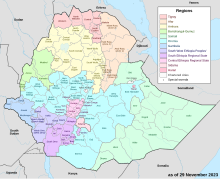
Dawro (or Dawuro) is a zone in the Southwest Region of Ethiopia. The name "Dawuro" represents both the land and the people. It is located at about 500km southwest of Addis Ababa, the capital of Ethiopia, about 111 km west of Wolaita Sodo, the capital of South Ethiopia Regional State and 319 km of Hawassa the capital of the Sidama Region. Dawuro is bordered on the south by Gofa Zone, on the west by the Konta Zone, on the north by the Gojeb River which defines its boundary with the Oromia Region, Jimma zone, on the northeast by Hadiya and Tembaro Special Woreda in Central Ethiopia Regional State, and on the east by Wolayita Zone; the Omo River defines its eastern and southern boundaries.
The second-biggest hydroelectric power generation dam in Ethiopia, Gilgel Gibe III Dam, is being built on Omo river between Dawuro and Wolayita zones. Dawuro contains many tourist attractions. The newly built Halala Kela Luxury Resort is located at Gilgel Gibe III Dam in Loma (woreda) of Dawuro zone. The administrative center of Dawuro is Tarcha. Tarcha is situated at 70 14' north latitude and 370 5' east longitude and 1200m to approximately 1450m above sea level. Tarcha is 505 km from Addis Ababa through Jimma, and 325 km through Sodo. The second largest town in the Dawuro zone is Gesa.
Dawuro has 111 kilometers of all-weather roads and 123 kilometers of dry-weather roads, for an average road density of 53 kilometers per 1000 square kilometers.[1] High points in this Zone include Atto, Issera, Umbuti, and Sadam among others.
Dawuro used to be part of the North Omo Zone, and the 1994 national census counted its inhabitants as part of that Zone. However friction between the various ethnic groups in North Omo zone, which was often blamed on the Welayta people for "ethnic chauvinism" and despite the efforts of the ruling party to emphasize the need to coordinate, consolidate, and unify the smaller ethnic units to achieve the "efficient use of scarce government resources", led to the division of the zone in 2000, resulting with the creation of the Dawuro, Gamo Gofa, and Wolayita Zones, and two special districts.[2]
- ^ "Detailed statistics on roads" Archived July 20, 2011, at the Wayback Machine, SNNPR Bureau of Finance and Economic Development website (accessed 3 September 2009)
- ^ Sarah Vaughan, "Ethnicity and Power in Ethiopia" Archived August 13, 2011, at the Wayback Machine (University of Edinburgh: Ph.D. Thesis, 2003), pp. 251 - 260